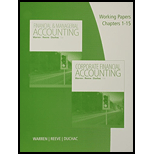
Accounting for materials costs
In papermaking operations for companies such as International Paper Company, wet pulp is fed into paper machines, which press and dry pulp into a continuous sheet of paper. The paper is formed at very high speeds (60 mph). Once the paper is formed, the paper is rolled onto a reel at the hack end of the paper machine. One of the characteristics of papermaking is the creation of “broke” paper. Broke is paper that fails to satisfy quality standards and is therefore rejected for final shipment to customers. Broke is recycled back to the beginning of the process by combining the recycled paper with virgin (new) pulp material. The combination of virgin pulp and recycled broke is sent to the paper machine for papermaking. Broke is fed into this recycle process continuously from all over the facility.
In this industry, it is typical to charge the papermaking operation with the cost of direct materials, which is a mixture of virgin materials and broke. Broke has a much lower cost than does virgin pulp. Therefore, the more broke in the mixture, the lower the average cost of direct materials to the department. Papermaking managers will frequently comment on the importance of broke for keeping their direct materials costs down.
a. How do you react to this accounting procedure?
b. What “hidden costs” are not considered when accounting for broke as described?
Trending nowThis is a popular solution!

Chapter 18 Solutions
Working Papers, Volume 1, Chapters 1-15 for Warren/Reeve/Duchac's Corporate Financial Accounting, 13th + Financial & Managerial Accounting, 13th
- general accounting questionarrow_forwardResidual claims stark, inc. is obligated to pay its creditors 14300 very soonarrow_forwardThe factory janitor's salary is a: a. Product and direct material cost. b. Product and direct labor cost. c. Product and manufacturing overhead cost. d. Period cost and Selling and Marketing expense. e. Period cost and General and Administrative expenses.arrow_forward
- In Bramble Corp.'s income statement, they report a gross profit of $44,000 at standard and the following variances: Materials price $420 F Materials quantity 600 F Labor price 420 U Labor quantity 1,000 F Overhead 900 F Bramble would report an actual gross profit of: a. $40,660. b. $47,340. c. $41,500. d. $46,500.arrow_forwardfinancial accounting questionarrow_forwardU-Too Everwear Corporation can manufacture mountain climbing shoes for $31.15 per pair in variable raw material costs and $22.50 per pair in variable labor expenses. The shoes sell for $156 per pair. Last year, production was 120,000 pairs. Fixed costs were $1,235,000. a. What were total production costs? b. What is the marginal cost per pair? c. What is the average cost per pair? d. If the company is considering a one-time order for an extra 5,000 pairs, what is the minimum acceptable total revenue from the order? Provide answer to me of this accounting questionarrow_forward
 Managerial AccountingAccountingISBN:9781337912020Author:Carl Warren, Ph.d. Cma William B. TaylerPublisher:South-Western College Pub
Managerial AccountingAccountingISBN:9781337912020Author:Carl Warren, Ph.d. Cma William B. TaylerPublisher:South-Western College Pub Financial And Managerial AccountingAccountingISBN:9781337902663Author:WARREN, Carl S.Publisher:Cengage Learning,
Financial And Managerial AccountingAccountingISBN:9781337902663Author:WARREN, Carl S.Publisher:Cengage Learning, Principles of Cost AccountingAccountingISBN:9781305087408Author:Edward J. Vanderbeck, Maria R. MitchellPublisher:Cengage Learning
Principles of Cost AccountingAccountingISBN:9781305087408Author:Edward J. Vanderbeck, Maria R. MitchellPublisher:Cengage Learning Cornerstones of Cost Management (Cornerstones Ser...AccountingISBN:9781305970663Author:Don R. Hansen, Maryanne M. MowenPublisher:Cengage LearningPrinciples of Accounting Volume 2AccountingISBN:9781947172609Author:OpenStaxPublisher:OpenStax College
Cornerstones of Cost Management (Cornerstones Ser...AccountingISBN:9781305970663Author:Don R. Hansen, Maryanne M. MowenPublisher:Cengage LearningPrinciples of Accounting Volume 2AccountingISBN:9781947172609Author:OpenStaxPublisher:OpenStax College




